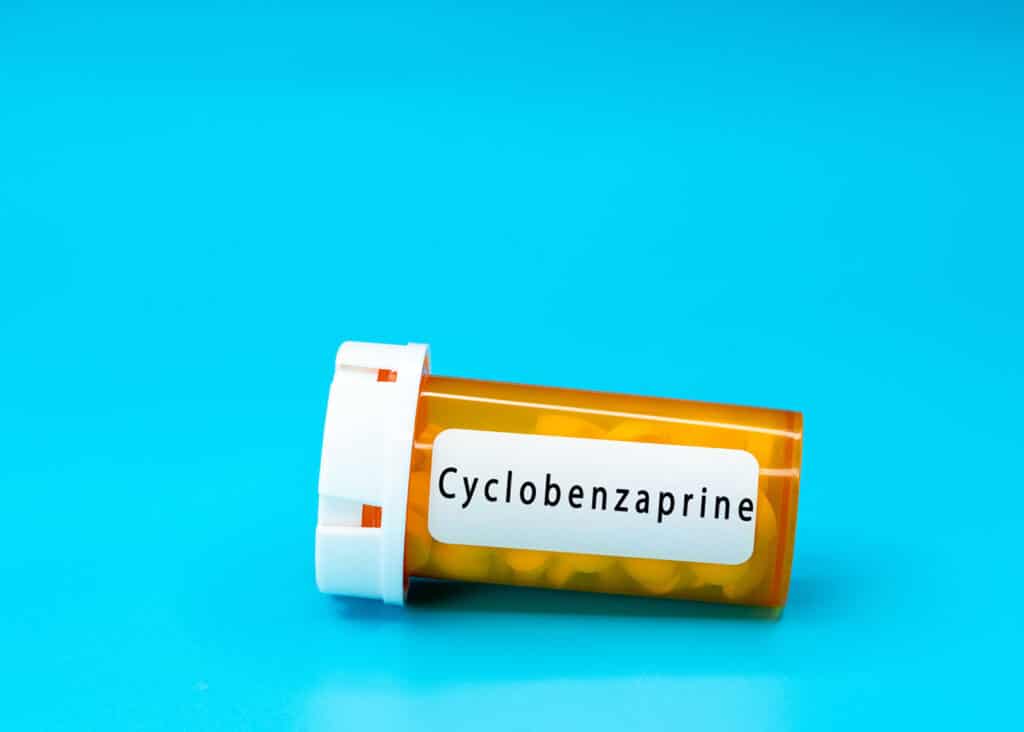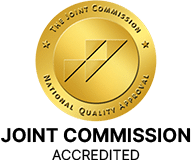If you or someone you know suffers from back pain, you may have come across a drug called Flexeril or another medication with the same active ingredient; cyclobenzaprine.
According to the DEA, more than 28 million prescriptions of medications containing Cyclobenzaprine were dispensed in 2017. The number of sold/picked-up cyclobenzaprine prescriptions was almost 27 million in 2018. In 2019, it was 26.7 million.
With so many people using cyclobenzaprine drugs, does this mean it’s completely safe? That’s what you’ll find out today.
In this guide, we’re sharing an in-depth look at cyclobenzaprine (Flexeril), from its composition and action to its side effects and potential abuse.

Table of Contents
What Is Cyclobenzaprine?
Cyclobenzaprine is the active constituent in Flexeril, Amrix, and various other drug brand names. It delivers a muscle-relaxing effect, so it can relieve pain and restricted motion resulting from muscle spasms.
The alleviating effects of cyclobenzaprine are short-time. They’re produced by the ability of cyclobenzaprine to act on the central nervous system and prevent hyperactive nerve endings from firing chemicals that trigger contraction in muscles.
As such, cyclobenzaprine is different from drugs that alleviate pain sensation by blocking pain receptors in nerves controlling the muscle, which means that the muscle will still contract but the patient won’t feel it.
Cyclobenzaprine also inhibits pain sensation and acts on the muscle itself to undo its spasming.
Thanks to its action as a muscle relaxant, medications containing cyclobenzaprine are often used to treat patients suffering from back pain or fibromyalgia.
Cyclobenzaprine can also be administered in the case of muscular dystrophy as it protects muscular tissue from damage by controlling muscle spasms.
Who should take it?
Cyclobenzaprine is a prescription-based drug that should only be taken by patients following doctors’ directions.
People suffering from pain, discomfort, and stiffness as a result of muscle sprains, strains, or injuries can take cyclobenzaprine medications in a certain dose that their doctor orders.
Adults and children, both older and younger than 15, can take cyclobenzaprine. The exact dose should be determined by a doctor.
How Do You Take Cyclobenzaprine?
As we mentioned above, patients should take Flexeril or any other cyclobenzaprine drugs only according to a doctor’s directions. The doctor will specify an appropriate dose depending on each patient’s case.
Proper Dosing
Still, there’s a guideline that explains the average doses of cyclobenzaprine as follows:
| Adults and children older than 15 years | Children younger than 15 years | |
| Tablets | 10 mg three times daily. The dose per day shouldn’t exceed 60 mg; six 10 mg tablets a day. | Dose and frequency are determined by the doctor. |
| Extended-release capsules | 15 mg once daily. Some conditions may call for 30 mg per day; either two 15 mg capsules or one 30 mg capsule. | Dose and frequency are determined by the doctor. |
Administration
When taking cyclobenzaprine orally, make sure you swallow the tablet or capsule whole.
The table is small enough to easily swallow, but if you’re having trouble downing the capsule whole, you can open it and dump its contents on a tablespoon of applesauce.
From there, swallow the mixture without chewing and drink some water after to ensure you’ve swallowed all the medication.
Storage
Keep your cyclobenzaprine drug in a closed container out of children’s reach. Keep it at room temperature away from direct light, heat, and moisture.
What if You Miss a Dose of Cyclobenzaprine?
You may forget to take a dose of cyclobenzaprine.
If this happens, take your usual dose as soon as possible unless it’s almost time for the next dose.
In that case, don’t take the missed dose and just follow your normal dosing schedule. Never take double the dose to make up for a missed dose.
Are There Side Effects To Taking Cyclobenzaprine?
Patients suffering from pain related to muscle injuries, strains, and sprains can experience elevated energy levels, enhanced motor skills, and improved sleep after taking Flexeril and other cyclobenzaprine medications.
However, they may also experience negative and potentially dangerous adverse effects ranging from mild to severe.
Examples include anxiety, disorientation, psychosis, as well as other nervous system and mental issues. Drowsiness can also result from taking cyclobenzaprine, so you should avoid tasks that require alertness while on the drug.
Here are some additional cyclobenzaprine side effects:
- Weight gain
- Nausea
- Dizziness
- Confusion
- Fatigue
- Headaches
- Constipation
- Abdominal pain
- Acid reflux
- Fever
- Nervousness
- Hallucinations
- Blurred vision
- Urination issues
Some of these side effects are due to the antihistamines activity of Flexeril, while others are the result of neurotransmitters malfunctioning in the brain.
What Are the Dangers of Cyclobenzaprine?
Besides the potential side effects of cyclobenzaprine, there’s also the possibility of tolerance, dependency, and addiction.
Dependency
Since cyclobenzaprine acts on the central nervous system, there’s a chance of the brain developing a tolerance to the drug.
In this case, the patient may end up increasing the dose on their own accord to be able to feel the drug’s effects. This can lead to cyclobenzaprine dependency.
Dependency is a physical reaction that occurs when the balance of chemicals in the brain requires a certain drug. It’s different from addiction and can happen independently, even if you take the drug for medical reasons and closely follow the proper dosage.
If a patient becomes dependent on cyclobenzaprine, they need medical intervention to help them stop taking the drug. Symptoms of cyclobenzaprine withdrawal can be so significant that the patient is overcome by cravings and ends up abusing the drug.
To manage cyclobenzaprine dependency, the doctor will gradually lower the dose instead of suddenly stopping the drug.
Abuse
The DEA hasn’t listed cyclobenzaprine as a controlled substance, but it can still be abused. This is due to the feeling of relaxation and sedation caused by the drug.
The produced state of long-lasting calmness, also known as “Flexeril high”, can be rather appealing to many substance abusers.
As a result, abusers will chase the high by taking cyclobenzaprine in higher doses and for a longer time than intended. That said, cyclobenzaprine isn’t narcotic or opioid.
Still, people abuse Flexeril in various ways; for example, crush and snort it or dissolve it in alcohol.
Abusers mostly mix cyclobenzaprine with illegal drugs or prescription medications because it enhances their effects. These include barbiturates, opioid painkillers, benzodiazepines, and other CNS depressants.
Recreational doses are commonly 20 or 80 mg, whereas generic doses are mostly 5 or 10 mg at a time.
Abusing cyclobenzaprine poses a major risk to the user because it can lead to an overdose (more on this below). Flexeril abuse can also cause addiction, which we’ll discuss next.
Addiction
Unlike dependency which is only a physical action, addiction is both a physical and behavioral reaction. According to the American Society of Addiction Medicine, addiction is a chronic, treatable medical disease.
Signs of Addiction
The biggest pointer to cyclobenzaprine addiction is when the person loses control over their use of the drug. Other signs of addiction include the following:
- The user requires a higher and higher dose of the drug to get the same effects.
- The user continues to take the drug for longer than prescribed by the doctor or after the treatment period is over.
- The user fakes symptoms to obtain cyclobenzaprine prescriptions.
- The user obsesses over the use, effect, and possible sources of the drug.
- The user shows sudden changes in behavior, hygiene, and appearance.
- The user is unable to stop taking the drug.
Overdose
When a user takes too much cyclobenzaprine than their body can metabolize and expel, an overdose occurs that negatively affects particular body functions.
The toxic dose of cyclobenzaprine is more than 100 mg, according to the Journal of Occupational Medicine and Toxicology.
The following are among the symptoms of cyclobenzaprine overdose:
- Dizziness
- Drowsiness
- Increased heart rate
- Nausea
- Confusion
- Agitation and severe nervousness
- Tremors
- Seizures
- Slurred speech
- Hypertension
- Hallucinations
- Breathing problems
- Losing the ability to control muscles
Cyclobenzaprine overdose can also cause less common but more serious side effects such as chest pain, irregular heartbeat, very low blood pressure, cardiac arrest, and seizures.
Flexeril overdose can also result in neuroleptic malignant syndrome with symptoms that include muscle rigidity, fever, and changed mental status.
Can Cyclobenzaprine Cause Withdrawal Symptoms?
Yes, cyclobenzaprine can result in unpleasant withdrawal symptoms. These happen when the drug suddenly leaves the bloodstream.
Symptoms of cyclobenzaprine withdrawal include fatigue, headaches, and nausea.
Long-term and heavy abusers of cyclobenzaprine can also experience discontinuation syndrome with the following withdrawal symptoms:
- Nausea and vomiting
- Insomnia
- Sweating
- Muscle aches
- Flu-like symptoms
Get Help for Yourself or a Loved One
It’s possible to treat cyclobenzaprine abuse and addiction with a combination of comprehensive medical detox and addiction treatment. The first step is to ask for help, so contact us today to start your rehabilitation journey
Frequently Asked Questions
Does cyclobenzaprine make you sleepy?
Is Flexeril a controlled substance?
Can you take extra strength Tylenol with Flexeril?
Can I take 20 mg of Flexeril at once?
Is Flexeril a benzo drug?



